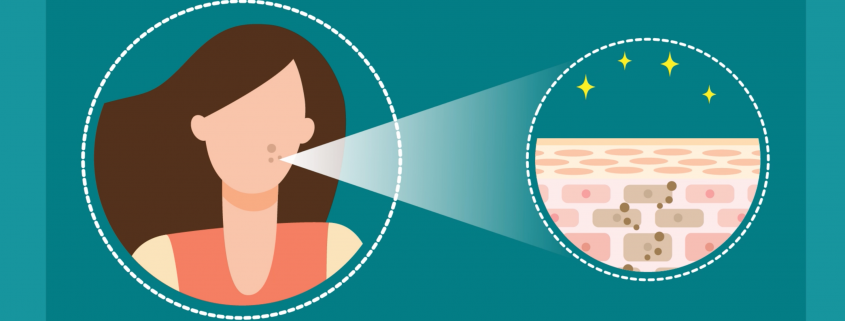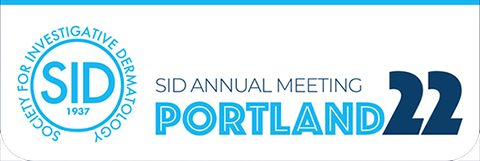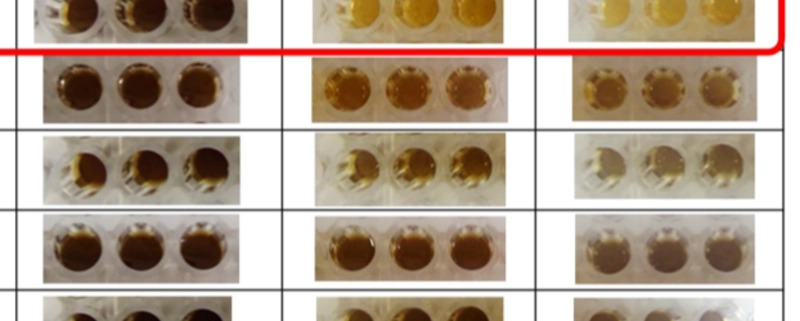Mediplus Pharma is presenting posters at Society for Investigative Dermatology(SID)annual meeting 2022
/in Cosmetic, R&D, Report /by mpp-yoshidaMediplus Pharma, Inc. (CEO: Kenji Ito, Head Office: Shibuya-ku, Tokyo,JAPAN) made a scientific presentation at the annual meeting of the Society for Investigative Dermatology (May 18-21, 2022, Portland, USA), which is considered the world’s highest-level society in dermatological research.
Title:Novel glycerin compounds improve skin health
Read moreNew ways to reduce facial age spots. Japanese Pharmaceutical R&D company Mediplus Pharma found the new ability of “High performance Glycerin” Effective in 92% of people after 8 weeks of continuous use.
/in Cosmetic, R&D, Report /by Mediplus PharmaFOR IMMEDIATE RELEASE
Mediplus Pharma, Inc. (CEO: Kenji Ito, Head Office: Shibuya-ku, Tokyo,JAPAN) confirmed that cosmetics containing its patented ingredient, high performance ozonized glycerin, have the effect of reducing melanin (age spots) in the epidermis, and filed a new application patent which claimed melanin decomposition.
Read moreThe 36th Japanese Nursing Association Compendium: “Deodorization effects of ozone products against unpleasant cancer odor.”
/in R&D, Report, Scientific Paper /by mph_suzukiAbstract:
The last stage of a human life is a crucial period for people and their family. Various approaches are being used to study the way people want to spend their last moments, including palliative care. In this study, we succeeded in drastically reducing the unpleasant cancer odor of a patient who had long been bothered by it by using ozone gel and ozone water. The treatment also cleansed the surface of the ulcer, suggesting that ozone gel might positively contribute to endstage medicine. This treatment suppressed the unpleasant odor and cleansed the patient’s body in her last stage, indicating that ozone gel might help people to spend their twilight years with dignity. With the hope of helping such patients, we intend to accelerate the development of medical products containing ozone gel and make them accessible as soon as possible. This case report summarizes an article presented at the 36th Japanese Nursing Association Compendium–General Nursing published by the Japanese Nursing Association on November 24, 2005.
Background:
At a conference organized by the Japanese Society of Pressure Ulcers held in 2004, we presented the efficacy of ozone gel in treating pressure sores. In that conference, we heard from few Osaka City General Hospital staff members who were troubled by the unpleasant cancer odors in their workplace.
One method to control the odor is packing (hermetically sealing) the lesion. However, packing the facial and cervical regions is difficult owing to their anatomical characteristics.
The unpleasant cancer odor is probably caused by anaerobic bacteria. Therefore, we presumed that ozone products (ozone gel, ozone water, etc.) might improve the unpleasant odor, because ozone is effective against anaerobic bacteria.
Methods:
In this case, the unpleasant odor could be sensed in an elevator hall 12 m away from the patient’s bed. Since conventional methods could not resolve the situation, we used ozone products (ozone gel and ozone water). Before the study, written consent of the patient and her family was obtained after the attending physician explained them that ozone has bactericidal and deodorizing properties with no harmful effects and that the results of the study would be published. The patient was assured that no personally identifiable information would be disclosed and they could withdraw their consent at any time.
Evaluation:
This study employed ozone gel, which was an ozonized glycerin compound, and ozone water, which was prepared by dissolving ozone in water. The ozone water was used for washing the tumor site, and the ozone gel was applied to the lesion after spreading it thinly on a piece of gauze.
(1) For odor measurement, the nurses were asked to subjectively evaluate the intensity of bad smell on a five-point scale: 1, Not smelly at all; 2, A little smelly; 3, Smelly; 4, Very smelly; and 5, Extremely smelly.
(2) All nurses working on the days of evaluation (7–8 in day shift; 2 in evening/night shift) subjectively evaluated changes in the odor at the entrance of the hospital room at 4:00, 9:00, 11:00, 17:00, and 23:00 hours.
(3) They made evaluations before and after using an air purifier and on Days 1 and 3 of using ozone gel. Thereafter, evaluations were made at 1-week intervals.
(4) The mean odor score was calculated for each evaluation day, and the changes in the scores were compared.
(5) The mean odor scale was calculated for each time point, and the changes in the score were compared between Phase 1 (before using ozone products) and Phase 2 (after using ozone products).
(6) The doctors, nurses, and family members were interviewed to obtain their subjective responses.
Progress and results:
1) Changes in the odor intensity on different evaluation days (see Figure 1)

In Phase 1, the mean odor score decreased by 0.3 points after using the air purifier.
In Phase 2, the mean odor score decreased by 0.9 points after using the air purifier to reach the score of 3.1 on Day 1 (November 19, Figure 1: Day 1 of using ozone gel). On Day 3 (November 21, Figure 1: Day 3 of using ozone gel), the odor score was 2.4, exhibiting a decrease of 1.6 points. Both doctors and nurses responded, “The smell was drastically reduced.” Despite the temporary reduction in the odor, many doctors and nurses sensed an intense odor as the amount of exudate from the lesion increased due to the expansion of the rupture site. On Day 10 (November 28, Figure 1: Day 10 of using ozone gel), the score was 3.4. To address this, Phase 3 was initiated the following day (November 29). The lesion was washed with ozone water concomitantly using the ozone gel. One week after starting ozone water washing (December 5, Figure 1: Day 7 of concomitantly using ozone water), the mean odor score decreased by 0.4 points. Regarding the ozone water washing, the doctors responded, “The surface of the tumor site became cleaner.” However, the condition of the patient exacerbated. As the tumor gradually grew, the patient had trouble breathing, and it became infeasible to cover the entire rupture site with gauze. Moreover, owing to her low consciousness level, she would often unconsciously remove gauze. Accordingly, the odor started intensifying again. Therefore, Phase 4 was initiated on December 6, wherein ozone water was sprayed on the lesion site. After 6 days, (December 12, Figure 1: Day 6 of concomitantly using spraying), the score decreased by 0.2 points to 2.8 compared to score obtained 1 week earlier.
2) Changes in the odor intensity at different time points (see Figure 2)

In Phase 1, before using ozone products, the highest odor score of 4.5 was recorded at 4:00; whereas the lowest score of 4.0 was noted at 17:00 and 23:00 hours. The difference between the scores was 0.5 points. In Phase 2, after using the ozone products, the lowest score of 2.7 was recorded at 11:00, i.e., immediately after replacing the gauze. The highest score of 3.2 was noted at 4:00, with the difference in the scores being 0.5 points. At all time points, the odor score was low after using ozone products.
3) Family’s response
The patient’s husband and younger sister were interviewed frequently before and after the study. Her husband said, “The smell does not bother me anymore. The difference is like night and day.” He also reported having been asked the reason behind alleviation of smell by a visitor of the patient.
ID. Discussion
Although the effect of the air purifier on the odor was evaluated in Phase 1, no considerable changes were noted due to its use. However, the odor score significantly decreased upon using ozone gel in Phase 2, and the odor score was lower at all time points after using ozone products than before using them. These results indicated that the ozone products were effective in eliminating the odor. Infection with anaerobic bacteria is believed to cause the unpleasant cancer odor. Ozone has bactericidal activity against anaerobic bacteria and can decompose sulfur generated by anaerobic bacteria. These properties were probably conducive in mitigating the odor.
In Phases 3 and 4, the odor intensified with tumor expansion and increasing exudation from the lesion. In this stage, the smell was successfully mitigated by the concomitant use of other ozone products. Although ozone water has a shorter effective duration than ozone gel, it can wash the affected site. Therefore, it was inferred that ozone water could exert synergetic effects with the concomitant use of long-lasting ozone gel. In a preceding study1), highly acidic water was used instead of ozone water. Given its stronger bactericidal activity, ozone water is likely to have higher deodorization efficacy than acidic water. Regarding unpleasant cancer odors, Watanabe et al.2) stated, “Patients are suffering from the uncontrollably unpleasant smell, which causes their families and friends to shy away from them. Simply denying the existence of such a bad smell does not help these patients at all, who became sensitive to their body odor. Even though the patients themselves may eventually stop worrying about the smell, it remains a problem for their families.” The patient in the present study (Ms. A) was aware of her bad smell due to decreased olfactory ability.
Moreover, she was troubled by the fact that her family members were repeatedly complaining about the smell. However, using the ozone products helped the patient in maintaining an amicable relationship with her family. In this study, the nurses subjectively scored the odor intensity based on their sense of smell. This resulted in a dispersion of scores even when measured simultaneously on the same day. Owing to the difference in the sense of smell of individuals, a large sample size and continuous measurement by the same observer will be required in future studies. In this study, we could have evaluated the efficacy of the products more objectively if we asked for cooperation from the family members who visited the patient daily.
Conclusion:
The use of ozone products alleviated the unpleasant cancer odor of the patient.
Investigation of Bactericidal and Fungicidal Effects of Stabilized Ozone Gel
/in R&D, Report, Scientific Paper /by mph_suzukiMediplus Pharma, Inc. (Formerly VMC Corporation) Gotaro Shiota
Yoshiaki Maruyama, Kikumi Suzuki
Showa University School of Dentistry, Department of Prosthodontics, Akihiko Shiba
Tokyo Medical and Dental University Graduate School of Medical and Dental Sciences, Shiba Kiyoko, Okamura Noboru,
Chida Toshio
Division of Laboratory Medicine, Chiba University Hospital, Asako Kimura
Development Background:
Disinfection with ozone gas or ozonated water is more useful than conventional disinfectants because it is effective on a wide spectrum of bacteria, yeast, mold, viruses, etc. and does not leave residue, preventing the emergence of resistant strains. However, ozone has a short half-life of less than one hour, which means that ozone must be generally produced where it is used, thus limiting its scope of application.
To overcome this shortcoming of ozone, we have developed a new ozone compound, stabilized ozone gel, using glycerin as a solvent, which can be stored long-term and has an expanded range of applications.
Objectives:
・Investigation of the bactericidal and fungicidal effects of stabilized ozone gel (OG) on various microbial species and inhibition of their growth over time.
・Examination of OG’s sterilization concentration and effects of storage.
Test strains for OG disinfection:
Standard strains
Escherichia coli ATCC25922
Pseudomonas aeruginosa ATCC27853
Staphylococcus aureus ATCC25923
Candida albicans IAM4966
Clinical isolates
Methicillin-resistant S. aureus (MRSA)
Staphylococcus epidemidis
Klebsiella pneumoniae
Salmonella enteritidis
Legionella pneumophila
Bacillus subtilis
Results:
We developed an effective disinfectant OG that can be stored.
The oxidation power of purified OG was extremely strong, and its bactericidal and fungicidal effects remained effective after dilution.
Similar to conventional ozonated water, it effectively eliminated a wide spectrum of microorganisms, and did so in a relatively short time.
Future outlook:
The applications of OG which have been limited thus far, will be expanded with this storable form. Furthermore, applications that take advantage of the properties of the solvent glycerin (hydrosolubility and moisture-retention) will also be explored for its potential as a treatment for pressure sores, as a mouthwash, or as a hand disinfectant.
Bactericidal and fungicidal effects of ozone gel
Methods: To determine the bactericidal and fungicidal effects of OG, Okamura’s semi-quantitative viable count method using a 96-well plate was used. First, about 108 CFU/ml of the microbial solution with 10 times the amount of OG are mixed, and after exposure time, sodium thiosulfate is mixed to stop the reaction, after which 10 µl of that admixture is placed in the 1st column prepared with the culture medium to make a 10-fold dilution series up to 12 columns sequentially. Then, the culture is incubated overnight at 37°C to observe how many columns have developed the bacterial and fungal growth, and calculate the count from the dilution ratio to take the semi-quantitative measurement.
With this measurement method, the limit of detection for the viable count is “102 CFU/ml or less,” which is not very precise. However, this method was selected aiming to present an introductory overview of the bactericidal and fungicidal effects of the novel compound OG.
・Effects of storage on the bactericidal effect of ozone gel

The results for S. aureus and E. coli are shown on the left and right graphs. The vertical axis shows the viable count, and the horizontal axis represents the exposure time. Compared to the controls (sterilized water and glycerin), newly purified OG and OG stored for 2 months after purification both demonstrated strong bactericidal effects that reduced the viable count below the limit of detection.
Bactericidal effects of ozone gel by concentration
・ Undiluted ozone gel
 The bactericidal power of undiluted OG was investigated in 6 species shown in the Table. With the exception of B. subtilis, a significant bactericidal effect was observed immediately after contact with OG until the viable count was below the limit of detection.
The bactericidal power of undiluted OG was investigated in 6 species shown in the Table. With the exception of B. subtilis, a significant bactericidal effect was observed immediately after contact with OG until the viable count was below the limit of detection.
The oxidizing power of undiluted OG was several hundred units, equivalent to several hundred ppm in ozone concentration. This exceeded the concentration of ozonated water, which is used as a disinfectant, so we diluted OG with glycerin to investigate its bactericidal effects at concentrations comparable to existing products.
・Bactericidal and fungicidal effects of 100 ppm OG

The bactericidal and fungicidal power of 100 ppm ozone gel was investigated in 6 species.
We observed the bactericidal and fungicidal effect over time up to an exposure time of 120 minutes. The results are shown on the slide. With the exception of B. subtilis, all other species reached the limit of detection within 1 min.
・Bactericidal and fungicidal effect of 10ppm ozone gel

The bactericidal and fungicidal power of 10 ppm ozone gel was investigated in 6 species.
We observed the bactericidal and fungicidal effect of OG over an exposure time upto 360 minutes. The results are shown on the slide. C. albicans, E. coli, P.aeruginosa, K. pneumoniae, and S. epidemidis reached the limit of detection at 1, 30, 30, 120, and 180 min, respectively.






